Abstract
The study draws attention to the importance of job satisfaction among blue collar workers at the two different plant locations of a leading railway manufacturing company situated in West Bengal. Blue collar workers constitutes of 85% of the working population in India, hence it is necessary that an in-depth study is conducted addressing the job satisfaction needs of these workers. This study delves into the job satisfaction of blue collar workers within an organization and thus, provides a microscopic insight upon the job satisfaction of blue collar workers with in an organization. The study encompasses 60 blue collar workers (30- P2 Plant, 30- P1 Plant), which constitutes for approximately 40% of the population of the blue collar workers within a leading railway manufacturing company. The study establishes that there is a difference in job satisfaction level of the blue collar workers at P2 plant and P1 plant. Furthermore, it establishes that there is in fact a relationship between the job satisfaction and location of work of blue collar workers in the company. The study, concludes by establishing that there is no relationship between age and job satisfaction, tenure of service and job satisfaction of blue collar workers, respectively. Hence, it demonstrates a comparative as well as a comprehensive outlook towards job satisfaction of the blue collar workers at one of India’s leading railway bogie manufacturing company
1. Introduction
1.1 Background of the study
In today’s competitive world the most valuable resource that an organization has within its possession is its man power. As we refer to the 4Ms of resource management: Manpower, money, material and method, each of these can benefit an organization by providing a competitive edge and improve performance through effective resource management. Using the 4Ms, it is feasible to determine which of the four M conditions is responsible for a fault mode.
In today’s competitive world Man power plays a very eminent role in shaping the environment of the organization. A man-power that is driven by motivation, culture and powered by high satisfaction level increases the viability of an organization that is destined to reach is organizational goals. Job satisfaction of the employee and workers in an organization is a key factor in determining the organizational climate. Both terms organizational climate and job satisfaction are intertwined: while job satisfaction is the employee’s perception and their attitude towards their work, organizational culture stems at perception of the attributes of the organization. Employee motivation, morale, and job satisfaction can all be raised by a positive organizational climate, while reduced productivity, fatigue, stress, and job dissatisfaction can all result from an unfavorable or toxic organizational culture.
This study aims at analyzing the job satisfaction among Blue Collar workers of the leading railway manufacturing company, for its P1 and P2 plants. The leading railway manufacturing company has 147 blue collar workers stretched across its P1 plant (49 workers) and P2 plant (98 workers). Being a manufacturing giant in the passenger rolling stock including trains and metros, designs and manufactures wagons such as container flats, grain hoppers, cement wagons, clinker wagons, and tank wagons, the backbone of the organization seems to be its blue-collar workers.
This study aims to provides a comparative analysis as to how the job satisfaction between two plants within an organization are affected due to various factors including elements about the work of a job that motivates the worker, sense of accomplishment, safety needs, need for recognition, team work, belongingness, etc. Therefore providing an insight into the job satisfaction level of the prime internal stakeholder at The leading railway manufacturing company.
1.2 Statement of the Problem
The aim of this study is to conduct a comparative analysis of job satisfaction among blue-collar workers at P2 and P1 plants within the leading railway manufacturing company. Despite being integral to the functioning of the company, blue-collar workers often face unique challenges in their work environment, which can significantly impact their job satisfaction. This research seeks to investigate the factors influencing job satisfaction, including but not limited to working conditions, organizational culture, and job security, in order to identify similarities and differences between the two plants. By understanding the determinants of job satisfaction in these contexts, this study aims to provide insights that can inform strategies for enhancing the well-being and productivity of bluecollar workers in manufacturing environments.
1.3 Introduction to the Topic
1.3.1. Job Satisfaction among Blue Collar Workers
Job satisfaction among blue-collar workers is a critical area of study within the realm of organizational psychology and management. Blue collar workers constitutes a sizable section of the global labor market and are vital to many sectors of the economy, including manufacturing. Hence, it is critical to comprehend their level of job satisfaction in order to boost output, lower attrition, and advance general wellbeing. Investigating the nuances of job satisfaction among blue-collar workers is therefore pertinent.
1.3.1.a. Theories Discussed – Maslow’s Hierarchy of Needs
As we delve into the arena of Job Satisfaction, motivational theories provide a basis for understanding the relevant factors that drive human behavior in the workplace. In Figure 1, Maslow’s Hierarchy of Needs posits that individuals are motivated by a hierarchy of needs, ranging from physiological needs to self-actualization. Blue-collar workers’ job satisfaction can be influenced by the extent to which their job fulfills these needs, such as providing adequate pay, job security, and opportunities for advancement.
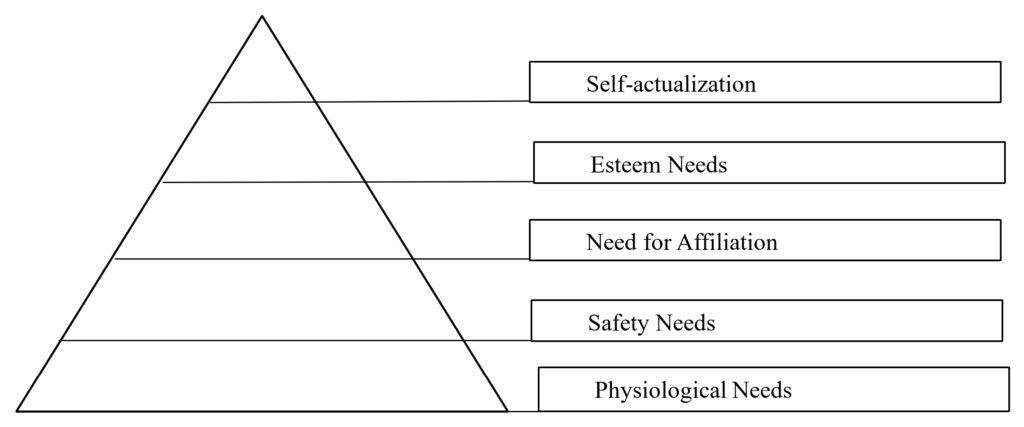
Figure 1: Maslow’s Hierarchy of Needs
- Psychological Needs: Physiological needs including food, water, shelter, and rest are ranks at the bottom of Maslow’s hierarchy of needs. Meeting these fundamental needs is critical to the wellbeing and job satisfaction of blue-collar workers. Fulfilling their physiological demands requires fair working hours, access to clean and safe working conditions, and adequate income that allows them to acquire basics. Where these primary and basic needs are not satisfied, blue-collar workers find it difficult to perform effectively and experience dissatisfaction in their roles. The physiological needs can be met with relation to blue collar workers if Organizations should adopt the statutory requirements under the labour laws like The Factories Act, 1948, Minimum Wages Act,1948, The West Bengal Shops and Establishment Acts, 1963, The Mines Act, 1952, that provides various provisions relating to the psychological needs of the blue collar workers.
- Safety Needs: On physiological needs being satisfied, individuals seek for security and safety. Blue collar workers are often exposed to situations that essentially put them in situations where they are susceptible to physical injuries and hazards that may be life threatening causing partial or total disablement, and in the worst-case scenario it may lead to death. Therefore, meeting the safety demands of blue-collar workers requires adopting emergency protocols, ensuring workplace safety measures, and offering appropriate training on equipment usage. Their sense of safety and well-being is also greatly influenced by job security and stability, against layoffs or downsizing.
- Need for Affiliation: People require interpersonal connections and a sense of belonging in addition to their basic needs for safety and physiology. Blue-collar workers build relationships and social connections within their teams by working opposite one another with their coworkers for extended periods of time. A welcoming workplace that makes employees feel appreciated, respected, and included promotes a feeling of community and togetherness. Blue-collar workers’ interpersonal relationships and workplace happiness can be strengthened through team-building exercises, collaborative possibilities, and open lines of communication.
- Esteem Needs: Esteem needs delve into the feelings of respect, acknowledgment, and achievement under Maslow’s hierarchy of needs. Blue-collar workers derive their esteem needs from: acknowledgment for their accomplishments, efforts, and abilities. This sense of self-worth and esteem in the job can be strengthened by chances for growth, skill development initiatives, and performance-based rewards within their jobs. Furthermore, when blue-collar workers are given the autonomy of decision making within their team, it provides a sense of freedom and autonomy, providing them a sense of pride in relation to the work they are involved in.
- Self-actualization: Most often, Blur-collar workers are involved in manual labor and specialized trades, thereby they are not usually connected with self-actualization endeavors. Due to their employment being perceived as primarily focused on providing basic requirements, such as stability and financial security. However, in the hindsight, there are ways, the concepts of self-actualization can be applied to the lives of blue-collar workers. Self-actualization represents the highest attainable level in Maslow’s hierarchy of needs. However, is not exclusive and limited to certain professions; blue-collar workers are certainly capable of personal development, creativity, and self-fulfillment. Whether through learning new skills, working through challenging problems, or participating in meritorious projects, blue-collar workers can have moments of self-actualization while performing their jobs. Encouraging these workers to follow their passions, explore relevant their interests, and set high achievable goals creates a culture of lifelong learning and growth, which in turn enriches their overall sense of job satisfaction and sense of fulfillment.
1.3.1.b. Theories Discussed Herzberg’s Two Factor Theory
Under Herzberg’s 2 factor theory, two categories of elements were identified by Prof. Frederick Irving Herzberg. As per Prof. Herzberg, the two categories of elements are: Hygiene factors and Motivators (Table 1).
Table 1: Hygiene factors and Motivators

This theory holds that contentment and discontent of an individual with regard to their job is impacted by distinct elements rather than being at opposite extremes of the same spectrum. Job satisfaction for blue-collar workers can be greatly impacted by motivators like opportunities for skill development and recognition for their achievements, but hygienic elements like fair wages and safe working conditions are also crucial in developing the sense of job satisfaction among the blue collar workers.
1.3.1.c. Theories Discussed – Vroom’s Theory of Expectancy or VIE , Theory of Work Motivation
According to Victor Harold Vroom’s theory of expectancy or VIE theory, individuals are driven to take action when they anticipate positive results. There are three variables: Valence, Instrumentality and Expectancy. Valence implies the strength of an individual’s preference for a particular outcome, which may include value, incentive, attitude and expected utility. Valence can be positive (the individual must prefer attaining the outcomes, rather than not attaining it), negative (the individual prefers not attaining the outcomes, rather than attaining it), or zero (the individual is indifferent towards the outcome). Instrumentality of the first level of outcomes in attaining the second level of outcomes, connotes towards another major input into valance. Expectancy signifies the probability (0 to 1) that an effort will lead to a certain first level of outcome, thereby the instrumentality that the first level of outcome will fetch an individual the second level of outcome. In case of blue collar worker, suppose a blue collar worker gets paid asper the pieces he assembles of a certain product the minimum benchmark being 30 an hour. If the company introduces an incentive program in the structure mentioned below it would motivate the blue collar workers to put in an effort for higher performance (first level outcome) and hence the desire to attain a higher incentive (second level outcome) (Table 2).
Table 2: Incentive Program

Thus when delving into the subject matter of blue collar workers and job satisfaction, the sense of job satisfaction among the blue collar workers is impacted by their conviction that hard labor that they put in their daily work will pay off in the form of incentives such as recognition, promotions, or career development (example: up-skilling). Hence, in order to attain high levels of job satisfaction among the blue collar workers, employers need to make sure that there is a clear connection between performance and rewards.
1.3.2. Factors affecting Job Satisfaction among Blue Collar workers
Job satisfaction among blue collar workers is influenced by both intrinsic and extrinsic motivators. Intrinsic factors signifies the nature of the work itself, opportunities for skill development, and the sense of accomplishment derived from completing tasks. Extrinsic factors involves pay, benefits, working conditions, job security, and relationships with supervisors and colleagues.
- The nature of the work: Repetitive and physically strenuous duties are widespread among blue-collar workers. Opportunities for creativity within their responsibilities coupled with the liberty to participate making decisions, can all have an impact on how satisfied employees are with their jobs.
- Compensation and benefits: In terms of compensation and benefits, the organizations that provide wages along with benefits asper the market standards after having done a proper market survey keeping in mind the rates at which the competitors are paying its blue collar workers can not only provide job satisfaction to the workers, but also provide the organization with a competitive edge.
- Working conditions: An organizations that tends to the safety needs of the blue collar workers who often engage in hazardous processes provides the blue collar workers a sense of security in terms of their life. Working conditions that ensure safety and comfort contribute to enhanced productivity and reduced level of stress. In addition proper equipment and ergonomic workspaces, combined with the above factors of safety can provide an enhanced level of job satisfaction.
- Recognition and appreciation: Through recognition of the contribution and efforts put forth by bluecollar workers in their daily work and achieving the departmental targets or organizational goals can boost the morale of the blue collar workers. They shall gain a sense of fulfillment and accomplishment with their jobs. Initiatives like incentives, bonus, verbal praise, awards like worker of the month in the structure of buddy systems can significantly contribute to the development of positive work environment.
- Career advancement opportunities: Blue-collar workers can be driven towards enhanced performance if the organization sets standards that enables them to progress in their career. Various initiatives and schemes for for skill development, training programs, and career advancement illustrates that the organization values the contribution and time of the workers and form a sense of belongingness among the blue collar workers. This in turn contributes towards building trust between the blue collar workers and the management, and provides assurance viable to both the workers and the organization in the long run.
2. Literature Review
On delving into the large volume research on job satisfaction, there is significantly fewer body of research the specifically caters to the comparative study of employee satisfaction of blue collar workers within an Indian organization. Nonetheless, it is important to review researches that holds a relatively within the proximity of proposed title of this research work:
- The relationship between job satisfaction and the viability of an organization at an industrial and organizational level connote towards the need for self-actualization and need for safety under Maslow’s Hierarchy of Needs. The study conducted propagated a comparative analysis of job satisfaction between industrial manager and accountants. The results shows that perceived need of job satisfaction between the managers and accountants trace back to selection errors lack of motivation among the sampled group. The motivational needs are recommended to be compensated by the correct training and development programs (Ivancevich & Strawser, 1969).
- Job satisfaction, as per Herzberg’s Two factor theory, is held single thread of continuous momentum. On one end of this thread is leveraged high satisfaction for the job while the other end connotes high level of dissatisfaction with regard to one’s job. Researchers conducted on Private and public sector employees comparing work environments and its possible implications on job satisfaction indicate public sector employees were more satisfied with their overall jobs than the private sectors employees. Furthermore, employees seeking hygiene factors are drawn towards public sector. However, the research connotes that hygiene factors and motivating factors were sources of satisfaction for both public and private sector (Maidani, 1991).
- Employee satisfaction has significant impact on their job performance. Researchers have made comparison between satisfaction level of employees in conventional banks and Islamic banks. The research considered nine indicators of job satisfaction: Job satisfaction, compensation and benefits, training and development, promotion, supervision, communication, career development, work-life balance and work environment. In both cases, showed high satisfaction with reference to conventional banks. The research was concluded by stating that Islamic banks should concentrate more on increasing the satisfaction level of employees at Islamic banks (Dooty et al., 2015).
- Research conducted to assess the “perception of need for satisfaction” between blue-collar workers in the United States and Mexico. Cultural differences were isolated as the independent variable by controlling for organizational and technology differences. The results of the research concluded that almost all of the need item scores differed significantly between the two nations. Mexican laborers reported higher levels of satisfaction than American counterparts (Slocum, 1971).
- A comparative study conducted to determine the job satisfaction levels of catalogers and reference librarians in university libraries showcase that there is no significant difference between the two categories in the samples. However the research indicated that catalogers are less satisfied than reference librarians pertaining to three distinct aspects of their jobs that includes creativity, variety and social service. Further it concluded by stating income/compensation as a factor correlated to job satisfaction (Chwe, 1978).
2.1 Identification of Literature Gap
In a country like India where middleclass is dominant, and is largely a developing country a significant section of the population are paid in terms of wages rather than salary. This section of population fit significantly below the benchmark of qualifying into the frame of middleclass. They draw wages on a daily basis and are largely within the spectrum of blue-collar workers. The extensive literature available largely caters to the job satisfaction available among the white collar workers of an organization, largely referred to as employees under various statutes in India. According to Business Standards dated December 13, 2023, which quoted the Indeed Report, there has been a 7.40% raise is hiring of blue-collar workers in India (study conducted between January to November 2023). In a country where blue-collar workers constitute approximately 85% of its workforce, it is crucial that their job satisfaction at micro level is measured. Upon consideration of the extensive literature on research of job satisfaction, there are relatively a handful of research particularly catering to the comparative analysis of job satisfaction among blue-collar workers within Indian organizations. This research thereby aims to focus on the job satisfaction levels of blue collar workers within an Indian organization considering two different plant locations. Thus, initiating an attempt towards a microscopic view of job satisfaction of blue collar workers in the vast ocean.
2.2 Objective and Scope of the Study
The study has the following primary objectives:
- To analyse the comparative job satisfaction level of blue collar workers at one of India’s leading railway manufacturing company belonging to P2 and P1 plant.
- To analyse if there is relation between job satisfaction and plant location of blue collar workers.
- To analyse if there is relation between job satisfaction and age of the blue collar workers.
- To analyse if there is relation between job satisfaction and tenure of service of the blue collar workers.
3. Research Methodology
The aforementioned chapter investigates and clarifies the primary philosophical perspective, which in turn justifies the research strategy and design for gathering primary data. A reason for the sample has been provided, and the research plan has been developed. In conclusion, the survey’s hypothesis has also been established, explained, and supported throughout the information analysis.
- Research Method: The method taken up for the purpose of this study is both quantitative and inferential in nature. Quantitative Research is used to measure the Relationship between job satisfaction among the blue collar workers at P2 and P1 Plants of The leading railway manufacturing company.
- Population of the Study: In this study the sampling frame were blue collar workers of P2 and P1 Plants at The leading railway manufacturing company. These was considered on the assumption that they have sufficient knowledge about their wellbeing and satisfaction level of their jobs.
- Sample Size: The Sample size of this study was 60 Blue Collar workers (40.3% of the total percentage of blue collar workers at The leading railway manufacturing company) 30 from P2 Plant and 30 from P1 plant, were picked randomly; amongst the total population of 149 of P1 and P2 Plants at The leading railway manufacturing company.
- Data Collection Methods: a) primary data was gathered during the survey that was done for this study. The primary methodology was a questionnaire survey, and b) secondary data were gathered through visiting pertinent published and unpublished publications of various researchers, including company website, books, journals, news paper and government papers.
- Statistical Models Used: a) Bar Graphs, b) Pie-Charts, and c) Percentage Analysis.
- Test of Hypothesis: T-test and Chi-Square Test
4. Data Analysis and Findings
Table 3: Analysis of Age of the respondents
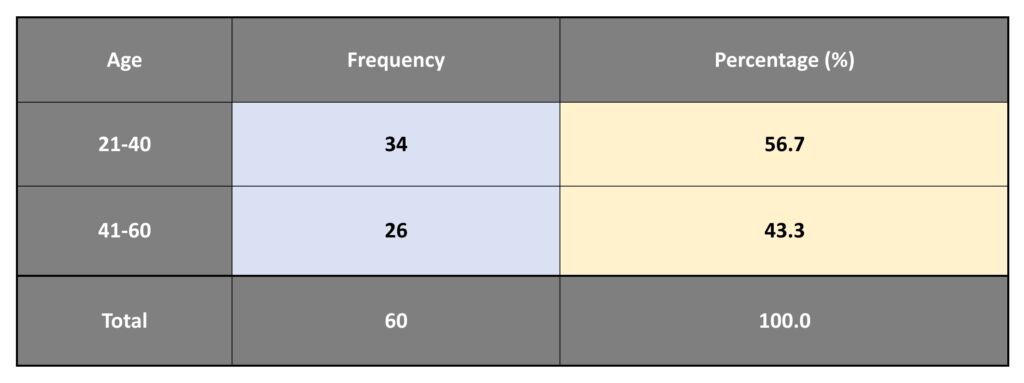
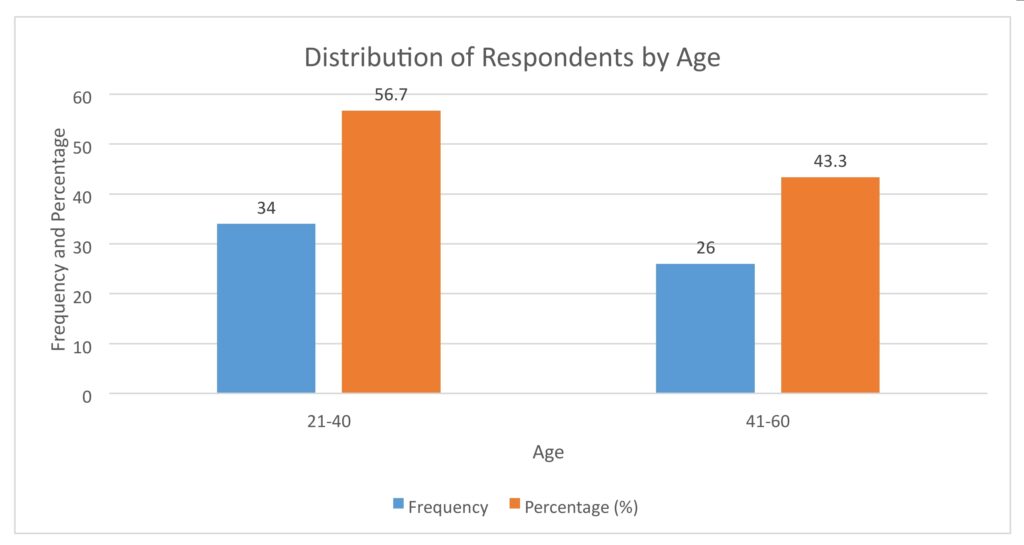
Figure 2: Distribution of Respondents by Age
The above table 3 and figure 2 show that majority (56.7%) of the respondents are between the ages of 21 and 40 years, the followed by the respondents that are between the ages of 41 and 60 years with the same percentage of (43.3%). It could be deduced from the result that the majority respondents of the survey ages between 21 and 40 years with (56.7%).
Table 4: Analysis of Tenure of Respondents

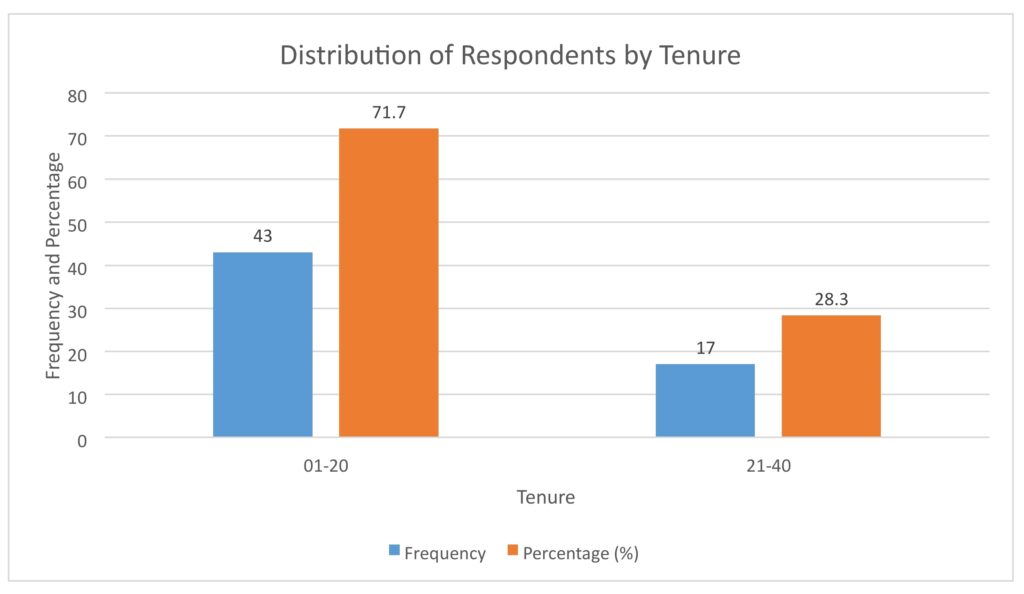
Figure 3: Distribution of Respondents by Tenure
It is observed from the above table 4 and figure 3 that 71.7% of the respondents have experience in the range of 1-20 years, whereas 28.3% respondents have experience of 21-40 years. From the responses collected, it can be deduced that majority of the respondents have experience in the range of 1 to 20 years.
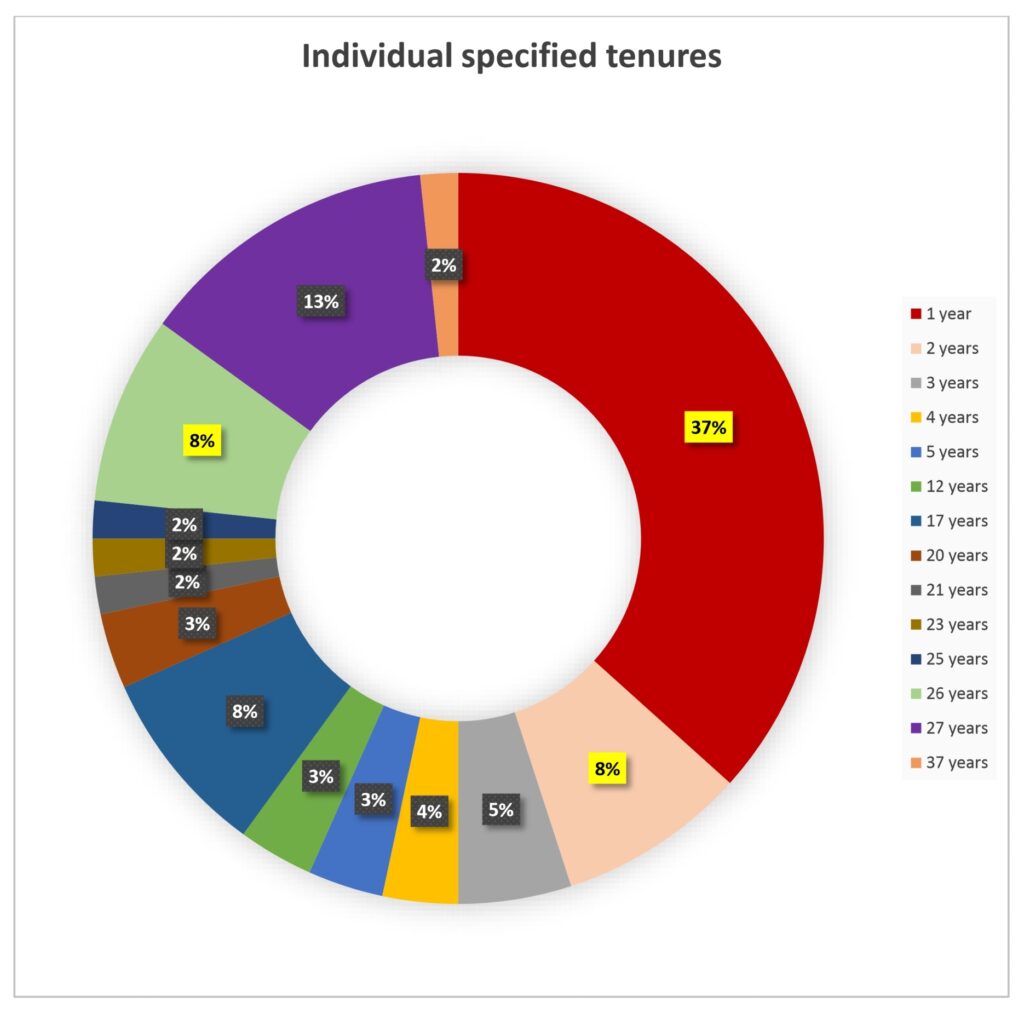
Figure 4: Individual Specified Tenures
The above chart (figure 4) donut pie chat provides the percentage of respondents that are present in individual tenure as per the raw data of the primary data. The largest percentage (37%) as visible are respondents belonging to 1 year tenure period. Followed by 8% in 2 years tenure and 28 year tenure.
4.1 Test of Hypothesis: Two sample T-Test with equal variance
To determine whether there is any statistically significance difference between the means of job satisfaction score of P2 Plant and P1 plant at 95% confidence level.
H0 (Null Hypothesis) : There is no difference in Job Satisfaction Score of the blue collar workers at P2 and Uttar para plants (µ1 = µ2).
H1 (Alternate Hypothesis) : There is difference in Job Satisfaction Score of the blue collar workers at P2 and Uttar para plants (µ1 = µ2)
At 5% significance level Therefore, α = 0.05
Table 5: for T-Test
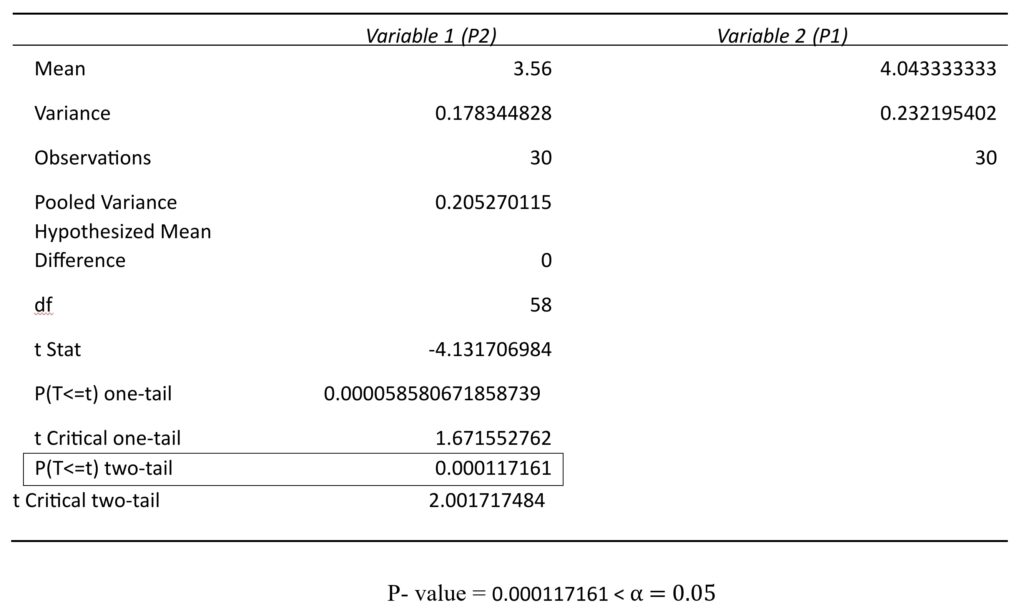
In table 5, Considering 5% significance level, the P-value obtained is less than 0.05, hence null hypothesis is rejected. It can be concluded that there is a statistically significant difference between the means of P2 and P1 plants. On looking at the means of both the plants, P1 plant seem to have a higher job satisfaction score than P2 (4.04 > 3.56).
4.2 Test of Hypothesis: Chi Square
4.2.1 Chi Square: Plant in which the respondent works and Job Satisfaction Score
To determine if there is any relationship between the plant in which the respondent works and the job satisfaction score, at 95% confidence level (Table 6).
H0 (Null Hypothesis): There is no relationship between plant in which the respondent works in and the employee satisfaction score.
H1 (Alternate Hypothesis): There is significant relationship between plant in which the respondent works in and the employee satisfaction score.
Table 6: Employee Satisfaction Score
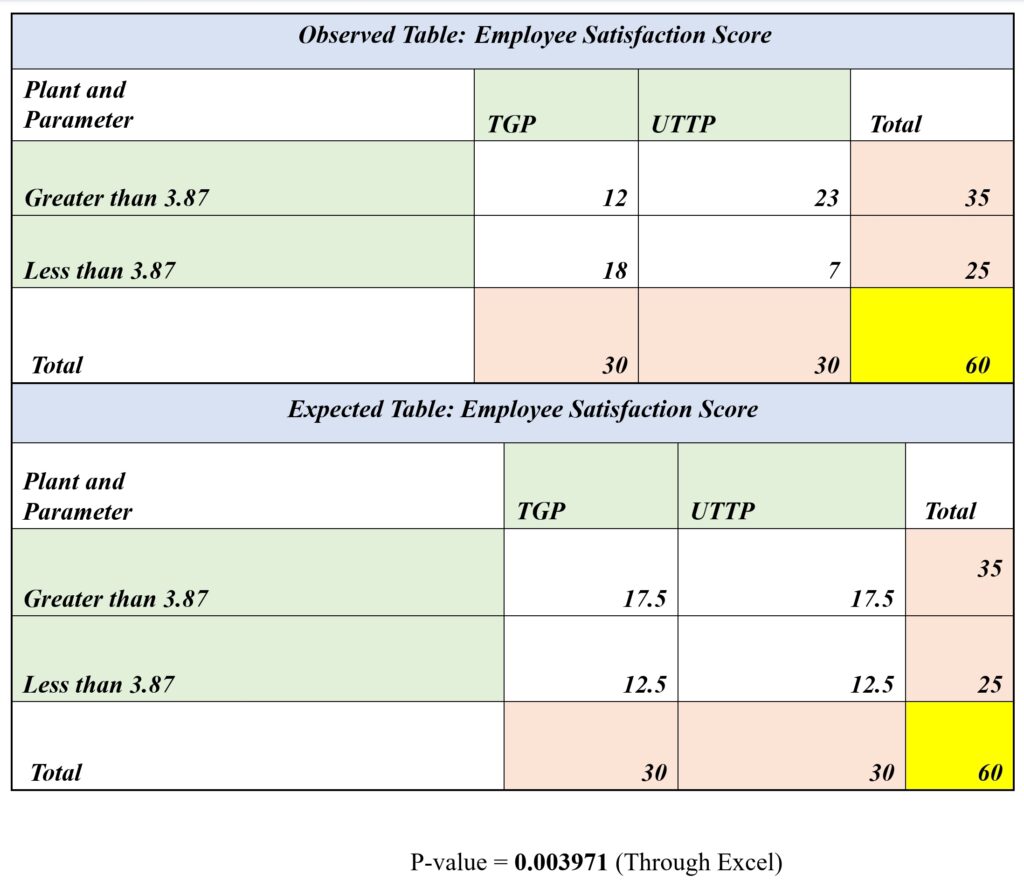
Considering 5% significance level, the p-value obtained is less than 0.05, as a result null hypothesis is rejected.
Therefore, it can be concluded that there is significant relationship between plant in which the respondent works in and the employee satisfaction score.
4.2.2 Chi Square: Job Satisfaction Score and Age
To determine if there is any relationship between job satisfaction score and the age of the respondents, at 95% confidence level (Table 7).
H0 (Null Hypothesis): There is no relationship between job satisfaction score and the age of the respondents.
H1 (Alternate Hypothesis): There is significant relationship between job satisfaction score and the age of the respondents.
Table 7: Job Satisfaction Score and Age
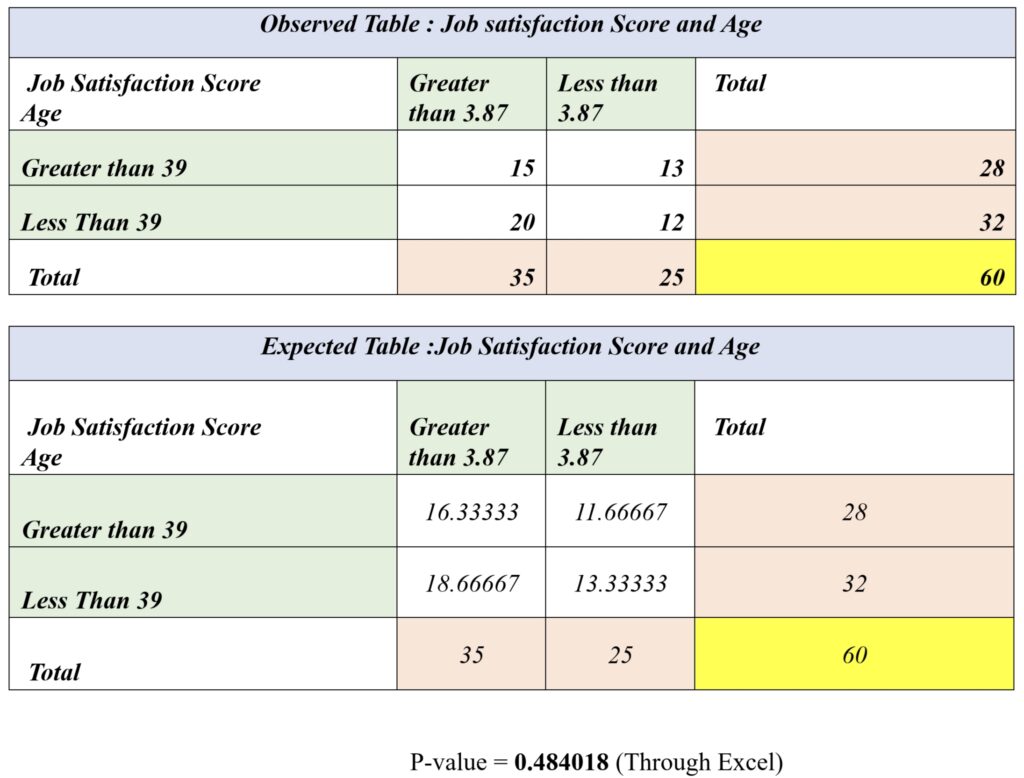
Considering 5% significance level, the p-value obtained is greater than 0.05, as a result null hypothesis is not rejected. Therefore, it can be concluded that there is no relationship between job satisfaction score and the age of the respondents.
4.2.3 Chi Square: Job Satisfaction Score and Tenure
To determine if there is any relationship between job satisfaction score and the age of the respondents, at 95% confidence level (Table 8).
H0 (Null Hypothesis): There is no relationship between job satisfaction score and the tenure of the respondents.
H1 (Alternate Hypothesis): There is significant relationship between job satisfaction score and tenure of the respondents.
Table 8: Job Satisfaction Score and Age
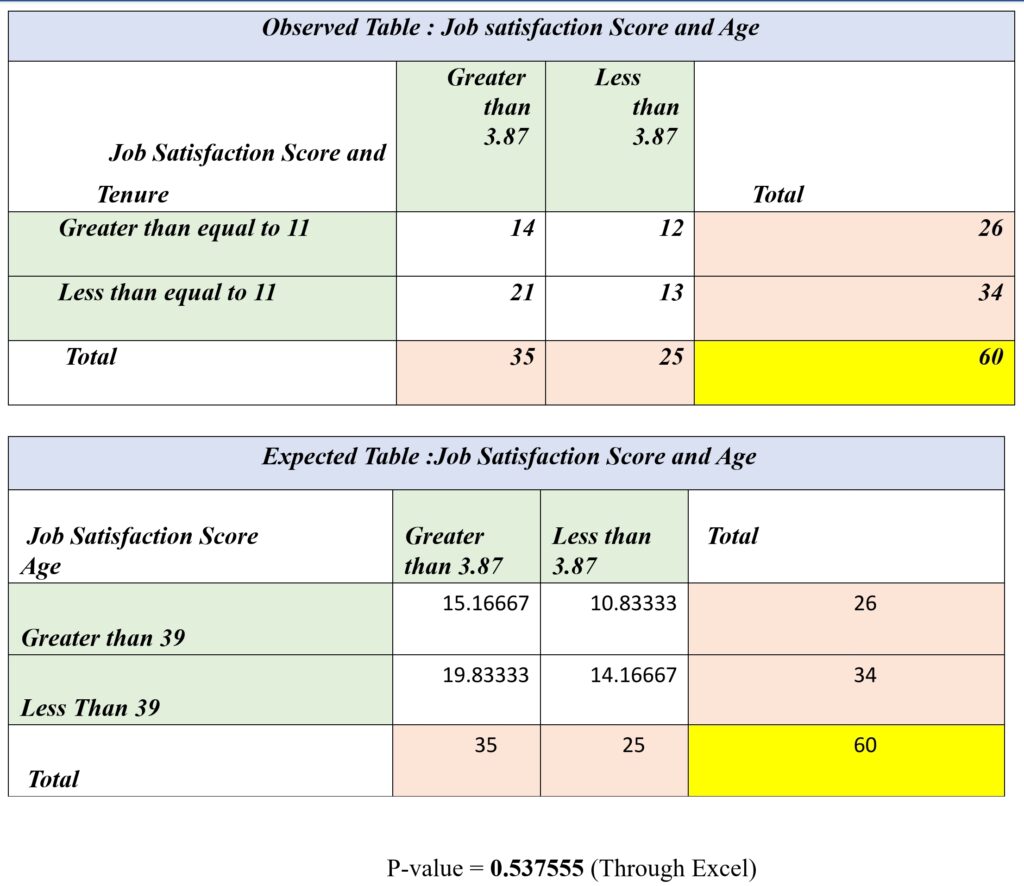
Considering 5% significance level, the p-value obtained is greater than 0.05, as a result null hypothesis is not rejected. Therefore, it can be concluded that there is no relationship between job satisfaction score and the tenure of the respondents.
4.3 Findings
- Upon conducting a test of hypothesis through two sample t-test it has been concluded that, there is a statistically significant difference between the means of P2 and P1 plants, which suggest a difference in the job satisfaction levels of the blue collar workers at P1 and Titagr plants. On comparing both the means of both the plants suggests that P1 plant seem to have a higher job satisfaction score than P2.
- The test of hypothesis through chi square suggests that, there is significant relationship between plant in which the respondent(s) works and their job satisfaction score. This chi square was conducted as a form of continuance to strengthen the outcomes of the two sample t-test conducted earlier. Through, this chi square test it was concluded that there is significant relationship between job satisfaction score and the respondent’s location or plant of work, which strengthens the outcome of the two sample t-test that showcased that accepted the alternate hypothesis of the means of the job satisfaction score is not equal, and there is a plant (P1) that has statistically higher job satisfaction score.
- The chi square conducted to understand if there is any relationship between job satisfaction and age of the respondent(s), concludes that there is no relationship between job satisfaction score and the age of the respondents.
- The chi square conducted to understand if there is any relationship between job satisfaction and tenure of service of the respondent(s), concludes that there is no relationship between job satisfaction score and the tenure of the respondents.
- The questionnaire yielded results suggesting 50% of 60 responded with agree to the questionnaire, 30% of 60 responded with neutral to the questionnaire, 20% of 60 responded with strongly agree to the questionnaire.
5. Conclusion and Recommendations
5.1 Conclusion
In the field of organizational psychology and management, job satisfaction among blue-collar workers is an important topic of research. A significant portion of the global labor force is made up of blue collar workers, who are essential to numerous economic sectors, including manufacturing. Job Satisfaction is an indispensable area of research, careful conduct of which might increase productivity, decrease attrition, and promote overall wellbeing of the organizations in a country like India. Through this study, it has been concluded that Job satisfaction among blue collar workers at The leading railway manufacturing company is higher at the P1 plant. Furthermore, it has been established through chi square test that there is a statistically significant relationship between the location of work of the blue collar worker and their job satisfaction. However, it has been established that there is no relationship between age and job satisfaction of the blue collar workers, and tenure of service and job satisfaction of the blue collar workers. A sizeable portion of the Indian population paid in wages rather than salaries. They are mostly classified as blue-collar workers and receive daily wages. Job satisfaction among these blue-collar workers is thus an intricate phenomenon, influenced by a gamut of external and intrinsic factors. Within the light of motivational theories and the knowledge about the distinct needs and preferences of these workers, organizations and management can foster a work environment that caters to engagement, contentment, and productivity.
5.2 Recommendations
- The organization required more workforce to combat the huge inflow of projects. For the same the organization needs to have an effective workforce planning system and head.
- After interviewing the workers during the survey, the workers seemed demotivated to work, the company should increase more appreciation and recognition measures for the workers.
- The company should include increase the feeling of belongingness for the workers. There seems to be an immense hierarchical gap between the officials and the workers. Bridging this gap by interaction and recognition measures can increase the motivational level of the workers.
All of the above mentioned recommendations can result increase in productivity and job satisfaction.
5.3 Limitations
- Time Constraint- Collecting data from candidates was difficult due to the limited two-month period of the internship.
- Limited access to data- Being an intern I didn’t have enough access to visiting the shop-floors and factory without supervision.
- Busy schedule of workers also affected the data collection to some extent.
- The study was based on a random sample so results may not be fully absolute.
- Fidelity of responses is very important in a research work however the primary data collected through questionnaire seemed inaccurate, this might be caused due to lack of trust or fear amongst the blue collar workers with respect to the management.
References
Ivancevich, J. M., & Strawser, R. H. (1969). A Comparative Analysis of the Job Satisfaction of Industrial Managers and Certified Public Accountants. Academy of Management Journal, 12(2), 193–203. https://doi.org/10.2307/254815
Sharma, E., & Mani, M. (2012). A Comparative Analysis of Employee Satisfaction in Indian Commercial Banks. IUP Journal of Organizational Behavior, 11(4), 38–61.
Ivancevich, J. M., & Baker, J. C. (1970). A Comparative Study of the Satisfaction of Domestic United States Managers and Overseas United States Managers. Academy of Management Journal, 13(1), 69–77. https://doi.org/10.2307/254926
Maidani, E. A. (1991). Comparative study of Herzberg’s two-factor theory of job satisfaction among public and private.. Public Personnel Management, 20(4), 441. https://doi.org/10.1177/009102609102000405
Chwe, S. S. (1978). A Comparative Study of Job Satisfaction: Catalogers and Reference Librarians in University Libraries. Journal of Academic Librarianship, 4(3), 139–143.
Slocum Jr., J. W. (1971). A Comparative Study of the Satisfaction of American and Mexican Operations. Academy of Management Journal, 14(1), 89–97. https://doi.org/10.2307/254713
Dooty, E. N., Fahim, S. T., & Sultana, I. (2015). A Comparative Analysis on Employee Satisfaction: A Study on Conventional and Islami Banks of Bangladesh. Romanian Economic & Business Review, 10(1), 99–105.
Tabassum, S. (2013). Occupational Stress among Employees of Public and Private Insurance Sector: A Comparative Study. Amity Global Business Review, 8, 80–91.
About this chapter
Cite this chapter
Shome, R. (2025). A Comparative Study on Job Satisfaction among Blue Collar Workers of Two Plants of a Leading Railway Manufacturing Company in West Bengal. In: VIVIBHA Uttarbanga: Proceedings. North Bengal Publications, India.
Edited by
Dr. Anirban Nandi
Book Title
VIVIBHA Uttarbanga: Proceedings
Copyright information
The Editor(s) (if applicable) and The Author(s), under exclusive license to North Bengal Publications : Live Life Happily Org. India 2025
ISBN
978-81-989058-1-9
